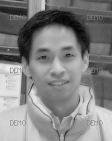Publications
CV download
25. Hsieh, P.-J., Colas, J.T., and Kanwisher, N. (in press). Pre-stimulus pattern of activity in the fusiform face area predicts face percepts during binocular rivalry. Neuropsychologia.
24. Hsieh, P.-J., Colas, J.T., and Kanwisher, N. (2011). Pop-out without awareness: Unseen feature singletons capture attention only when top-down attention is available. Psychological Science. 22, 1220-1226. (PFD)
23. Lashkari, D., Sridharan, R., Vul, E., Hsieh, P.-J., Kanwisher, N.G., Golland, P. (in press). Search for patterns of functional specificity in the brain: A nonparametric hierarchical Bayesian model for group fMRI data. NeuroImage.
22. de Graaf, T.A., Hsieh, P.-J., Sack , A.T. (in press). The 'correlates' of neural correlates of consciousness. Neuroscience and Behavioral Reviews.
21. Lashkari, D., Sridharan, R., Vul, E., Hsieh, P.-J., Kanwisher, N., Golland, P. (2010). Nonparametric hierarchical Bayesian model for functional brain parcellation. in Proc. MMBIA: IEEE Computer Society Workshop on Mathematical Methods in Biomedical Image Analysis. 15-22. (PDF)
20. Fedorenko, E., Hsieh, P.-J., Nieto-Castanon, A., Whitefield-Gabrieli, S., and Kanwisher, N. (2010). A new method for fMRI investigations of language: Defining ROIs functionally in individual subjects. Journal of Neurophysiology. 104, 1177-1194. (PDF)
19. Hsieh, P.-J., Vul, E., and Kanwisher, N. (2010). Recognition alters the spatial pattern of fMRI activation in early retinotopic cortex. Journal of Neurophysiology. 103, 1501-1507. (PDF) (Faculty 1000 Recommendation)
18. Hsieh, P.-J., and Tse, P. U. (2010). 'Brain-reading' of perceived colors reveals a feature mixing mechanism underlying perceptual filling-in in cortical area V1. Human Brain Mapping. 31, 1395-1407. (PDF)
17. Hsieh, P.-J., and Tse, P. U. (2010). BOLD signal in both ipsilateral and contralateral retinotopic cortex modulates with perceptual fading. PLoS ONE. 5, e9638. (PDF)
16. Kohler, P. J., Caplovitz, G. P., Hsieh, P.-J., Sun, J., and Tse, P. U. (2010). Motion fading is driven by perceived, not actual angular velocity. Vision Research. 49, 439-50. (PDF)
15. Hsieh, P.-J., and Tse, P. U. (2009). Feature mixing rather than feature replacement during perceptual filling-in. Vision Research. 49, 439-50. (PDF)
14. Hsieh, P.-J., and Tse, P. U. (2009). Microsaccade rate varies with subjective visibility during motion-induced blindness. PLoS ONE. 4: e5163. (PDF)
13. Hsieh, P.-J., and Tse, P. U. (2009). Motion fading and the motion aftereffect share a common process of neural adaptation. Attention, Perception and Psychophysics. 71(4), 724-33. (PDF)
12. Caplovitz, G. P., Barroso, D. J., Hsieh, P.-J., and Tse, P. U. (2008). fMRI reveals that neuronal feedback to ventral retinotopic cortex underlies perceptual grouping by temporal synchrony. Human Brain Mapping. 29(6), 651-661. (PDF). (Demo of stimuli. Download and play in loop mode.)
11. Tse, P.U., and Hsieh, P.-J. (2007). Component and intrinsic motion integrate in 'dancing bar' illusion. Biological Cybernetics. 96(1), 1-8. (PDF). (Demo of stimuli. Download and play in loop mode.)
10. Troncoso, X. G., Tse, P. U., Macknik, S. L., Caplovitz,, G. P., Hsieh, P.-J., Schlegel, A. A., Otero-Millan, J., and Martinez-Conde, S. (2007). BOLD activation varies parametrically with corner angle throughout human retinotopic cortex. Perception. 36, 808-820. (PDF).
9. Hsieh, P.-J., and Tse, P.U. (2007). Grouping inhibits motion fading by giving rise to virtual trackable features. Journal of Experimental Psychology: Human Perception and Performance. 33(1), 57-63. (PDF). (Demo of stimuli.)
8. Hsieh, P.-J., Caplovitz, G. P., and Tse, P.U. (2006). Bistable Illusory Rebound Motion: Event-related functional magnetic resonance imaging of perceptual states and switches. NeuroImage. 32(2), 728-739. (PDF). (Demo of stimuli.)
7. Hsieh, P.-J., and Tse, P.U. (2006). Illusory color mixing upon perceptual fading and filling-in does not result in 'forbidden colors'. Vision Research. 46 (14), 2251-2258. (PDF). (Demo of stimuli.)
6. Hsieh, P.-J., and Tse, P.U. (2006). Stimulus factors affecting illusory rebound motion. Vision Research. 46 (12), 1924-1933. (PDF).
5. Hsieh, P.-J., Caplovitz, G. P., and Tse, P.U. (2006). Illusory motion induced by the offset of stationary luminance-defined gradients. Vision Research. 46 (6-7), 970-978. (PDF). (Demo of stimuli.)
3. Tse, P.U., Caplovitz, G. P., and Hsieh, P.-J. (2006). Microsaccade directions do not predict directionality of illusory brightness changes of overlapping transparent surfaces. Vision Research. ;46(22), 3823-3830
2. Caplovitz, G. P., Hsieh, P.-J., and Tse, P.U. (2006). Mechanisms underlying the perceived angular velocity of a rigidly rotating object. Vision Research. 46(18), 2877-2893. (PDF).
1. Hsieh, P.-J., Caplovitz, G. P., and Tse, P. U. (2005). Illusory Rebound Motion and Motion Continuity Heuristic. Vision Research. 45 (23), 2972-2985. (PDF).
